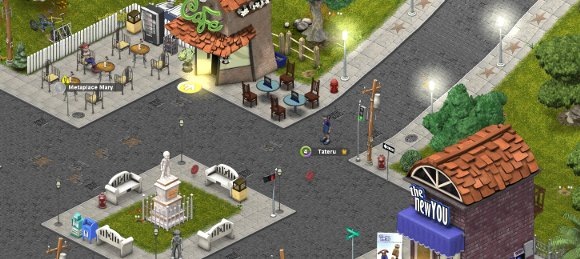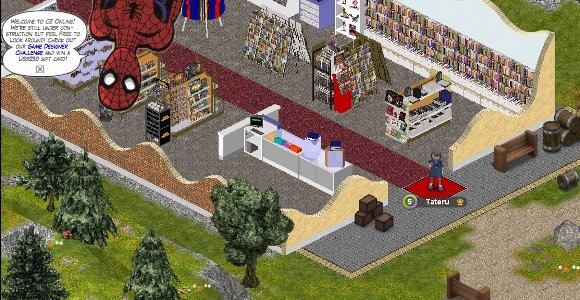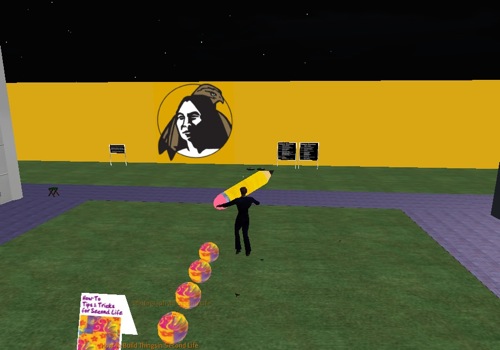1. PNN Online (USA) – MacArthur Island Opens in Virtual World of Second Life. “The MacArthur Foundation Island opened today in the virtual world of Second Life. The island is a new laboratory for MacArthur’s two-year exploration of virtual worlds, led by the University of Southern California and the nonprofit Global Kids. MacArthur Island is designed as an alternative space to educate grantees and others about the potential for philanthropy in virtual worlds and allow grantees and Foundation partners to showcase their work and connect with new audiences. The new island is located adjacent to an archipelago in Second Life dedicated to the public good, called the Nonprofit Commons. Visitors to MacArthur Island can interact with installations created about the work of MacArthur and its grantees. They include a giant pair of 3D headphones that visitors can use to listen to stories by independent radio producers as part of Public Radio Exchange, and a map about Chicago neighborhoods through which visitors can learn about a comprehensive community development effort being carried out in Chicago. ”
2. WebProNews (USA) – Kids/Teens Drawn to Virtual Worlds, Not Marketers. “What do you get when you cross a video-game with social networking? Virtual worlds – and they’re no joke, particularly with younger generations who are immersing themselves in increasing numbers.
In fact, half of online kids (age 3-11) will be regular frequenters to virtual worlds by 2013, predicts eMarketer. In its new report, “Kids and Teens: Growing Up Virtual”, the research firm estimates that currently 37% of online kids log on to virtual worlds each month. By 2013, that proportion is expected to rise to 50%, or 8.7 million.”
3. Multiplayer Online Games Directory (USA) – Footballvillage.net Worldwide Opening with FC Barcelona Virtual World. “E-Calcio is Proud and Happy to Announce the Opening of Footballvillage.net. It’s the result of over 2 years of development with 150 people involved in the creation of an innovative virtual world environment dedicate to the football passion. The target it’s to give to the largest number of users a very immediate and easy to use access to the virtual worlds experience and a chance to live and share with other friends all over the world their true football passion.”
4. ZDNet Asia (Singapore) – Virtual worlds an inroad to new generation. “Virtual worlds aren’t dead–they’re enjoying a re-awakening, as marketers learn to connect both the real and virtual, say observers. Mary Ellen Gordon of Market Truths, a U.S.-based research firm specializing in virtual worlds, said in an interview with ZDNet Asia, companies expressing interest in virtual worlds such as Second Life are compelled to learn the media-consumption habits of the new generation. This marks a contrast against the initial wave of companies which flocked to Second Life for mostly publicity, and also “during which at least some companies did not seem to take the time to really understand virtual worlds or to think about how to use them to contribute to their overall business objectives”, said Gordon. She named some of these business needs as saving time and costs related to traveling, by using virtual platforms to carry out Web conferences.”
5. Kotaku (USA) – Are Our Games Alive? “Anyone who’s played through a game like Microsoft’s Fable II (who can forget your virtual dog?), BioWare’s Mass Effect (with its robust roster of non-playable characters) or seen Sony’s upcoming Heavy Rain (whose developer, Quantic Dream, promises a new type of relationship between player and character) may have wondered to themselves whether gaming, which is still in its infancy as an art form, is heading towards its inevitable Citizen Kane threshold. More than the graphics or surround sound, the latest game consoles’ processing power are bringing to life AI-controlled characters unlike anything experienced before. But what are these sentient beings that help or hinder gamers as they explore vast virtual worlds? Are the Locust Horde who hide behind blockades and orchestrate flanking attacks in Gears of War 2 the first step in some type of real-world AI nightmare like the apocalyptic future displayed in Warner Bros. Pictures’ Terminator: Salvation? Will Steven Spielberg’s next original game for Electronic Arts, which remains untitled, deliver on its promise of making a gamer connect with a female avatar emotionally?”
6. Hi-Tech Scotland (UK) – Scotswoman scores ‘Second Life’ Gold. “Dunfermline businesswoman Pauline Randall’s office looks out over sparkling blue oceans, lapping around lush, landscaped gardens and she can fly to meetings in an instant – all in her Virtual World business park. This week, (Wednesday 27th May, San Francisco) it was announced she is the first, and only, Scottish company accepted into Linden Lab’s Gold Solution Provider Program in recognition of her experience and expertise in helping companies enter and operate in Second Life. Pauline runs her company, virtual-e, to recreate 3D replica offices and buildings online for organisations like Imperial College, London, Ashridge Business School, CyMAL – Wales Museums and Libraries and the University of Hawaii. In these online spaces, organisations can host virtual meetings, collaborative working, product training and demonstrations – even international conferences, without the cost and hassle of travel. Medical colleges are using virtual worlds for training young doctors in diagnosing patients and businesses find them an innovative way to manage 360 degree presentations on new products.”
7. VentureBeat (USA) – Virtual events draw a live in-person crowd. “Yes, these people in the picture are real. What’s weird is they’re attending a conference about virtual events. You know, the kind they have only in cyberspace where you pretend you’re at a live event. As surreal as it sounds, the fledgling virtual events industry gathered today at a first-of-its-kind Virtual Edge event at the Santa Clara Convention Center in Santa Clara, Calif. While other conferences have been pummeled by the recession, there were 500 people registered and an overflow crowd this morning. The reason for the interest is that demand for virtual events has skyrocketed during the recession, said Malcolm Lotzof, chief executive of Chicago-based virtual events firm InXpo, one of several companies that stage the virtual events for all sorts of customers. As companies seek to cut costs and curtail travel, they’ve come to see the wisdom of putting on virtual events on the Internet.”
8. Mail & Guardian Online (South Africa) – A new world of study. “There’s not a red pen in sight when Russell Stannard marks his master’s students’ essays — but it’s not because they never make mistakes. Stannard doesn’t use a pen to give his students feedback. Instead — and in keeping with his role as principal lecturer in multimedia and Information & Communication Technology (ICT) — he turns on his computer, records himself marking the work on-screen, then emails his students the video.”
9. ITWorld Canada (Canada) – Immersive Internet technology is no video game. “A Kirksville, Mo.-based non-profit organization providing drug abuse counseling services is taking a Second Life-esque approach to continuing to treat clients once they leave residential treatment centres. For the past two months, Preferred Family Healthcare Inc. has been running its own virtual islands on a private server where young adults who have spent some time in residential care can continue to receive counseling remotely using only a provided laptop and Internet connection.”
10. The Escapist (USA) – PlayStation Home Users On The Rise. “After an initial peak of interest followed by a dip in activity, PlayStation Home’s active user base is now on the upswing, according to Home director Peter Edward. PlayStation Home has had a reputation for being the biggest budgeted ghost town of all of gaming’s virtual worlds, but that might not actually be the case, according to Home director Peter Edward. While the feature saw very little use after an initial surge of interest following its debut, people are apparently going back Home, and they’re staying there.”




 Views of spaces can be customized, UI widgets can be added. There’s a great deal of support for building game-spaces, and if I were able to spare the time for making a game, Metaplace is definitely where I’d want to be doing it.
Views of spaces can be customized, UI widgets can be added. There’s a great deal of support for building game-spaces, and if I were able to spare the time for making a game, Metaplace is definitely where I’d want to be doing it.


Recent Comments